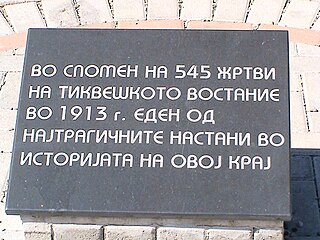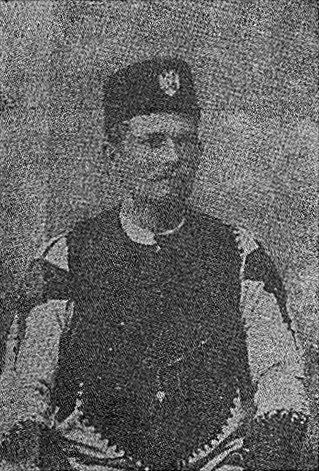
Tikvesh uprising was an uprising in the Tikveš region of Macedonia in late June 1913.
Milivoje Trbić, known as Vojče (Војче) or Voja (Воја), was a Yugoslav army captain (kapetan) and member of the Chetniks during World War II in Yugoslavia.

Gligor Sokolović was one of the supreme commanders of the Serbian Chetnik Movement, that fought the Ottoman Empire, Bulgarian, and Albanian armed bands during the Macedonian Struggle. He was one of the most famous Chetniks, and the foremost in Western Povardarie. In Bulgaria he is considered a Bulgarian renegade who switched sides, i.e. (sic) Serboman.

Vasilije Trbić was a Serbian Chetnik commander in Macedonia who became a politician in the Kingdom of Serbs, Croats and Slovenes, first representing the People's Radical Party (NRS) in the country's National Assembly and later the Yugoslav National Party (JNP). Born in the village of Bijelo Brdo, near Dalj in Austria-Hungary, Trbić was a monk in his youth. He fled Mount Athos after being accused of murdering several fellow monks and joined the nationalist band of Jovan Drimkolski in 1904–05, quickly becoming the unit's commander. Trbić fought alongside Serbian forces during the Balkan Wars and during World War I, earning the Order of the Star of Karađorđe for his efforts. Acting alongside other former Chetnik commanders, he participated in establishing organizations whose purpose was to raise monuments to Serbian military successes from 1912–18 and to promote cultural development in Macedonia in the interwar period. He died in 1962.

The Serbian Revolutionary Organization or Serbian Chetnik Organization was a paramilitary revolutionary organization with the aim of liberation of Old Serbia from the Ottoman Empire. Its Central Committee was established in 1902, while the Serbian Committee was established in September 1903 in Belgrade, by the combined Central Boards of Belgrade, Vranje, Skopje and Bitola. Its armed wing was activated in 1904. Among the architects were members of the Saint Sava society, Army Staff and Ministry of Foreign Affairs. It operated during the Struggle for Macedonia, a series of social, political, cultural and military conflicts in the region of Macedonia; its operations are known as Serb Action in Macedonia.

Spasa Pavlović, known as Spasa Garda or Zmaj, was a Serbian Chetnik commander in Old Serbia during the Macedonian Struggle (1903–1908). He received his nicknames from his high stature and bravery, and could be entrusted with highly secretive missions. He was born in the village of Stanča near Kriva Palanka, Ottoman Empire. From 1903, he was a jatak for the Serbian bands whom he led the way in the woods and hills, and since 1904 he was a vojvoda (duke) in the Kriva Palanka area. His band defended the Kriva Palanka region from the IMRO, securing the Kriva river, which region was controlled by Serbian bands and where all villages were adhering to the Patriarchate and included in the Serbian Chetnik Organization. Spasa participated in all major battles on the left bank of the Vardar river. There, he helped destroy the local Bulgarian secret organization and Turkish (Ottoman) government. He is famed for his bravery in the battle on Paklište. After the Young Turk Revolution (1908), he returned to his village and lived a peaceful life. However, with the breakout of the First Balkan War, he joined the unit of Vojin Popović-Vuk, as the Serbian vanguard, and participated in all battles from the Serbian border to Prilep. He was wounded but declined medical care. He was killed in action in the fights for Prilep, on November 7, 1912, on the Alinački vis. He was buried in Prilep.

Anđelko Aleksić was a Macedonian Serb Chetnik commander (voivode). He and Đorđe Cvetković led the first two armed bands of the Serbian Chetnik Organization, sent from the Kingdom of Serbia into Ottoman Macedonia to fight for the liberation of Macedonia.

Stevan Nedić, nicknamed Ćela (Ћела), was a Serbian Chetnik commander in Old Serbia and Macedonia.

Trenko Rujanović, known as Vojvoda Trenko, was a Macedonian Serb Chetnik and Bulgarian apostate.

Rade Radivojević, known as Vojvoda Dušan (Душан), was a Serbian Chetnik vojvoda in Old Serbia and Macedonia during the Macedonian Struggle.

Zafir Premčević was a Serbian Chetnik commander in Old Serbia and Macedonia during the Macedonian Struggle, who also participated in the Balkan Wars and World War I.

Danilo "Dane" Stojanović was a Serbian Chetnik commander in Old Serbia and Macedonia (1904–08), who also participated in the Balkan Wars (1912–13). He was also known as Dane Krapče.

Krsta Kovačević, known as Krsta Trgoviški, was a Serbian Chetnik commander that was active in Old Serbia and Macedonia during the Macedonian Struggle (1903–08), then participated in the Balkan Wars (1912–13) and World War I (1914–18). In Bulgaria he is considered a Bulgarian renegade who switched sides, i.e. (sic) Serboman.

Jovan Cvetković, known as Jovan Dolgač, was a Serbian Chetnik commander in Macedonia, who also participated in the Balkan Wars and World War I in the Chetnik detachments of the Serbian Army. In Bulgaria he is considered a Bulgarian renegade who switched sides, i.e. (sic) Serboman.

Jovan Stanojković, known by his nom de guerre, the demonym Dovezenski (Довезенски), was a Serbian Chetnik commander (vojvoda), and participant in the Balkan Wars, in the Battle of Kumanovo, and World War I. He was originally a teacher who turned into a guerilla fighter following Bulgarian oppression on Serb people in Macedonia. He rose in ranks and became one of the supreme commanders in Macedonia.

Aleksandar Marković, known by his nickname Cene, was a Serbian Chetnik commander (voivoda) in Macedonia, in the Balkan Wars and World War I.

Boško Mitrović, known by the nom de guerreVirjanac (Вирјанац) or Virčanac (Вирчанац), was a Serbian Chetnik commander.
On August 6, 1904, there were murders in Kokošinje of Serbs carried out by the IMRO Bulgarian bands of Atanas Babata. Parts of the IMRO, which supported the Bulgarian Exarchate, executed notable Serbs, who supported the Patriarchate of Constantinople.

Đorđe Cvetković, known by the nom de guerreDrimkolski (Дримколски), was a Serbian Chetnik vojvoda (commander) of the četa (band) of Drimkol.

The Bulgarian occupation of Serbia during World War I started in Autumn 1915 following the invasion of Serbia by the combined armies of Germany, Austria-Hungary and Bulgaria. After Serbia's defeat and the retreat of its forces across Albania, the country was divided into Bulgarian and Austro-Hungarian occupation zones.

















